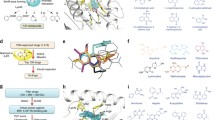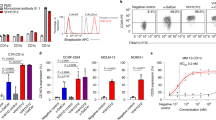Summary
CD4+ T lymphocytes, which orchestrate immune responses, receive a cognitive signal when clonally distributed receptors are occupied by peptides bound to major histocompatibility complex (MHC) class II molecules on antigen-presenting cells. The latter cells provide costimulatory or accessory signals through macro-molecules such as B7.1 and B7.2, which interact with coreceptors on T cells to regulate outcomes in terms of T cell activation or specific nonresponsiveness. Complementary studies of the interactions between antigen-presenting cells and T helper cells at the chemical level have implicated Schiff base formation between specialised carbonyls and amines, constitutively expressed on the surfaces of antigen-presenting cells and T cells, as an essential element in specific T cell activation. Small Schiff base-forming molecules can substitute for the natural donor of carbonyl groups and provide a costimulatory signal to the T cell.
From this class of Schiff base-forming costimulatory molecules, the small xenobiotic substituted benzaldehyde, tucaresol, has been selected for development and testing as an immunopotentiatory drug. Tucaresol, which is orally bioavailable and systemically active, enhances CD4+ T helper cell and CD8+ cytotoxic T cell responses in vivo, and selectively favours a T helper 1 profile of cytokine production. In murine models of virus infection and syngeneic tumour growth it has substantial therapeutic activity. Schiff base formation by tucaresol on T cell surface amines provides a costimulatory signal to the T cell through a mechanism that activates clofilium-sensitive K+ and Na+ transport. The pathway utilised by tucaresol converges with T cell receptor signalling at the level of mitogen-activated protein (MAP) kinase, promoting the activation of MAP kinase kinase (MEK) and consequential tyrosyl phosphorylation of ERK2.
Tucaresol is the first orally active, mechanism-based immunopotentiatory drug available for therapeutic testing. It is currently undergoing phase I/II clinical trials in chronic hepatitis B virus infection, HIV infection and malignant melanoma.
Similar content being viewed by others
References
Hendrick SM, Eidelman FJ. T lymphocyte antigen receptors. In: Paul W, editor. Fundamental immunology. 3rd ed. New York: Raven Press, 1993: 383–420
Weiss A. T lymphocyte activation. In: Paul W, editor. Fundamental immunology. 3rd ed. New York: Raven Press, 1993: 467–504
Lenschow DJ, Bluestone JA. T cell costimulation and in vivo tolerance. Curr Opin Immunol 1993; 5: 747–52
Whittington R, Faulds D. Interleukin-2: a review of its pharmacological properties and therapeutic use in patients with cancer. Drugs 1993; 46: 446–514
Klima N, Pataraca R, Walling J, et al. Clinical and immunological changes in AIDS patients following adoptive therapy with activated autologous CD8 T cells and interleukin-2 infusion. AIDS 1994; 8: 1073–81
Hendrzak JA, Brunda MJ. Interleukin-12: biologic activity, therapeutic utility, and role in disease. Lab Invest 1995; 72: 619–37
Tahara H, Lotze MT. Anti-tumor effects of interleukin 12 (IL-12): applications for the immunotherapy and gene therapy of cancer. Gene Ther 1995; 2: 96–106
Nabel GJ, Chang AE, Nabel EG, et al. Immunotherapy for cancer by direct gene transfer into tumors. Hum Gene Ther 1994; 5: 57–77
Fenton RT, Sznol M, Luster DG, et al. A phase I trial of B7-transfected or parental lethally irradiated allogeneic melanoma cell lines to induce cell-mediated immunity against tumor associated antigen presented by HLA-A2 or HLA-A1 in patients with stage IV melanoma. NCI protocol T93-0161. BRMP protocol 9401. Hum Gene Ther 1994; 5: 1385–99
Rhodes J. Evidence for an intercellular covalent reaction essential in antigen specific T-cell activation. J Immunol 1989; 143: 1482–89
Gao X-M, Rhodes J. An essential role for constitutive Schiff base-forming ligands in antigen presentation to murine T cell clones. J Immunol 1990; 144: 2883–90
Rhodes J. E-rosettes provide an analogue for Schiff base formation in specific T cell activation. J Immunol 1990; 145: 463–9
Rhodes J, Zheng B, Lifely MR. Inhibition of specific T cell activation by monosaccharides is through their reactivity as aldehydes. Immunology 1992; 75: 629–31
Zheng B, Brett S, Tite JP, et al. Galactose oxidation in the design of immunogenic vaccines. Science 1992; 256: 1560–3
Rhodes J, Chen H, Hall SR, et al. Therapeutic potentiation of the immune system by costimulatory Schiff base forming drugs. Nature 1995; 377: 71–5
Thompson CB. Distinct roles for the costimulatory ligands B7-1 and B7-2 in T helper cell differentiation? Cell 1995; 81: 979–82
Bluestone JA. New perspectives on CD28-B7-mediated T cell costimulation. Immunity 1995; 2: 555–9
Allison JP. CD28-B7 interactions in T-cell activation. Curr Opin Immunol 1994; 6: 414–9
Leach DR, Krummel MF, Allison JP. Enhancement of anti-tumour immunity by CTLA-4 blockade. Science 1996; 271: 1734–6
Bell GM, Imboden JB. CD2 and the regulation of T cell anergy. J Immunol 1995; 155: 2805–7
Hargreaves R, Logiou V, Lechler R. The primary alloresponse of human CD4+ T-cells is dependent on B7 (CD80), augmented by CD58, but relatively uninfluenced by CD54 expression. Int Immunol 1995; 7: 1501–13
Shevach EM. Accessory molecules. In: Paul W, editor. Fundamental immunology. 3rd ed. New York: Raven Press, 1995: 531–75
August A, Dupont B. CD28 of T lymphocytes associates with phosphatidylinositol 3-kinase. Int Immunol 1994; 6: 769–77
August AS, Gibson Y, Kawakami T, et al. CD28 is associated with and induces the immediate tyrosine phosphorylation and activation of the Tec family kinase ITK/EMT in the human Jurkat leukemic T-cell line. Proc Natl Acad Sci USA 1994; 91: 9347–50
Li W, Whaley CD, Mondino A, et al. Blocked signal transduction to the ERK and JNK protein kinases in anergic CD4+ T-cells. Science 1996; 271: 1272–6
Fields PE, Gajewski TF, Fitch F. Blocked Ras activation in anergic CD4+ T-cells. Science 1996; 271: 1276–8
Vogelzang NJ, Lestingi TM, Sudakoff G, et al. Phase I study of immunotherapy of metastatic renal cell carcinoma by direct gene transfer into metastatic lesions. Hum Gene Ther 1994; 5: 1357–70
Rubin J, Charboneau JW, Reading C, et al. Phase I study of immunotherapy of hepatic metastases of colorectal cancer by direct gene transfer. Hum Gene Ther 1994; 5: 1371–84
Goedegeburne PS, Douville LM, Richmond DC, et al. Adoptive immunotherapy with tumor-infiltrating lymphocytes and interleukin-2 in patients with metastatic malignant melanoma and renal cell carcinoma: a pilot study. J Clin Oncol 1995; 13: 1939–49
Bauer M, Reaman GH, Hank JA, et al. A phase II trial of human recombinant interleukin-2 administered as a 4-day continuous infusion for children with refractory neuroblastoma, non-Hodgkins lymphoma, sarcoma, renal cell carcinoma, and malignant melanoma: a Childrens Cancer Group study. Cancer 1995; 75: 2959–65
Heaton KM, Grimm EA. Cytokine combinations in immunotherapy for solid tumors: a review. Cancer Immunol Immunother 1993; 37: 213–9
O’Garra A, Murphy K. Role of cytokines in determining T-lymphocyte function. Curr Opin Immunol 1994 6: 458–66
Del-Prete G, Maggi E, Romagnani S. Human Th 1 and Th2 cells: functional properties, mechanisms of regulation, and role in disease. Lab Invest 1994; 70: 299–306
Mosmann TR, Sad S. The expanding universe of T-cell subsets: Th1, Th2 and more. Immunol Today 1996; 17: 138–46
Gately MK, Gubler U, Brunda MJ, et al. Interleukin 12: a cytokine with therapeutic potential in oncology and infectious disease. Ther Immunol 1994; 1: 187–96
Clerici M, Shearer GM. The Th1-Th2 hypothesis of HIV infection: new insights. Immunol Today 1994; 15: 575–81
Snell EE, Dimari SJ. Schiff base intermediates in enzyme catalysis. In: Boyer PD, editor. The enzymes: kinetics and mechanism. Vol 2. London: Academic Press, 1973: 335–46
John RA. Pyridoxal phosphate-dependent enzymes. Biochim Biophys Acta 1995; 1248: 81–96
Fersht A. Covalent catalysis. In: Enzyme structure and mechanism. 2nd ed. New York: W.H. Freeman, 1984: 69–97
Van der Meer RA, Duine JA. Covalently bound pyrroloquinoline quinone is the organic prosthetic group of human placental lysyl oxidase. Biochem J 1986; 239: 789–91
Stryer L. Excitable membranes and sensory systems. In: Biochemistry. 3rd ed. New York: W.H. Freeman, 1988: 1005–41
Mukohata Y. Comparative studies on ion pumps of the bacterial rhodopsin family. Biophys Chem 1994; 50: 191–201
Sasaki J, Brown, LS, Chon Y-S, et al. Conversion of bacteriorhodopsin into a chloride ion pump. Science 1995; 269: 73–5
Rolan PE, Parker JE, Gray SJ, et al. The pharmacokinetics, tolerability and pharmacodynamics of tucaresol (589C80; 4-[2-formyl-3-hydroxyphenoxymethyl]benzoic acid), a potential anti-sickling agent, following oral administration to healthy subjects. Br J Pharmacol 1993; 35: 419–25
Seger R, Krebs EG. The MAPK signalling cascade. FASEB J 1995; 9: 726–35
Dudley DT, Pang L, Decker SJ, et al. A synthetic inhibitor of the mitogen-activated protein kinase cascade. Proc Natl Acad Sci USA 1995; 92: 7686–9
Greenlaw R, Robinson P, Heaton T, et al. Transfection of HLADR-expressing DAP.3 cells with a cDNA clone encoding the glycosyl phosphatidylinositol-linked form of lymphocyte function associated antigen-3: biochemical features and functional consequences. Int Immunol 1992; 4: 673–80
Wyss DF, Choi JS, Maria JL, et al. Conformation and function of the N-linked glycan in the adhesion domain of human CD2. Science 1995; 269: 1273–8
Malkovsky M, Edwards AJ, Hunt R, et al. T-cell mediated enhancement of host-versus-graft reactivity in mice fed a diet enriched with vitamin A acetate. Nature 1983; 302: 338–40
Malkovsky M, Medawar PB, Thatcher DR, et al. Acquired immunological tolerance of foreign cells is impaired by recombinant interleukin 2 or vitamin A acetate. Proc Natl Acad Sci USA 1985; 82: 536–8
Buck J, Derguini F, Levi E, et al. Intracellular signalling by 14-hydroxy-4,14-retro-retinol. Science 1991; 254: 1645–56
Derguini F, Nakanishi K, Hämmerling U, et al. Intracellular signaling activity of synthetic (14R)-, (14S)-, and (14RS)-14-hydroxy-4,14-retro-retinol. Biochemistry 1994; 33: 623–8
Meydani SN, Ribaya-Mercado JD, Russell RM, et al. Vitamin B6 deficiency impairs interleukin 2 production and lymphocyte proliferation in elderly adults. Am J Clin Nutr 1991; 53: 1275–80
Rall C, Meydani SN. Vitamin B6 and immune competence. Nutr Rev 1993; 51: 217–25
Deeg HJ. Ultraviolet irradiation in transplant biology: manipulation of immunity and imunogenicity. Transplantation 1988; 45: 845–51
Ullrich SE, Modulation of immunity by ultraviolet radiation: key effects on antigen presentation. J Invest Dermatol 1995; 105 (1 Suppl.): 30–6S
Kripke ML. Ultraviolet radiation and immunology: something new under the sun [presidential address]. Cancer Res 1994; 54: 6102–5
Soltysik S, Wu JY, Recchia J, et al. Structure/function analysis of QS-21 adjuvant: assessment of triterpene aldehyde and glucuronic acid roles in adjuvant function. Vaccine 1995; 13: 1403–10
Apostolopoulos A, Pieterz GA, Loveland BE, et al. Oxidative/ reductive conjugation of mannan to antigen selects for T1 or T2 immune responses. Proc Natl Acad Sci USA 1995; 92: 10128–32
Tzianobos AO, Onderdonk AB, Rosner B, et al. Structural features of polysaccharides that induce intra-abdominal abscesses. Science 1993; 262: 416–9
Tzianobos AO, Onderdonk AB, Smith RS, et al. Structure-function relationships for polysaccharide-induced intra-abdominal abscesses. Infect Immun 1994; 62: 3590–3
Sherman DI, Williams R. Liver damage: mechanisms and management. Br Med Bull 1994; 50: 124–38
Edmonds SE, Ellis G, Gaffney K, et al. Hypoxia and the rheumatoid joint: immunological and therapeutic implications. Scand J Rheumatol Suppl 1995; 101: 163–8
Love RA, Rader JI, Crofford LJ, et al. Pathological and immunological effects of ingesting L-tryptophan and 1,1′-ethylidenebis-(L-tryptophan) in Lewis rats. J Clin Invest 1993; 91: 804–11
Dreskell WJ, Ashley DL, Grainger J, et al. Identification of decomposition products of 1,1′-ethylidenebis-(L-tryptophan), a compound associated with eosinophilia-myalgia syndrome. Bull Environ Contam Toxicol 1992; 48: 679–87
Pol S. Immunotherapy of chronic hepatitis B by anti HBV vaccine. Biomed Pharmacother 1995; 49: 105–9
Redfield RR, Birx DL. HIV-specific vaccine therapy: concepts, status, and future directions. AIDS Res Hum Retrovir 1992; 8: 1051–8
Barth A, Hoon DS, Foshag LJ, et al. Polyvalent melanoma cell vaccine induces delayed-type hypersensitivity and in vitro cellular immune response. Cancer Res 1994; 54: 3342–5
Author information
Authors and Affiliations
Rights and permissions
About this article
Cite this article
Chen, H., Hall, S., Zheng, B. et al. Potentiation of the Immune System by Schiff Base-Forming Drugs. BioDrugs 7, 217–231 (1997). https://doi.org/10.2165/00063030-199707030-00005
Published:
Issue Date:
DOI: https://doi.org/10.2165/00063030-199707030-00005




